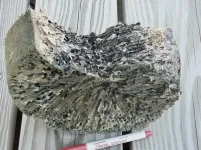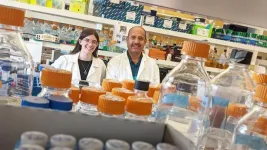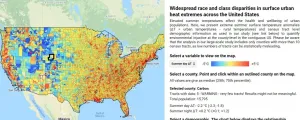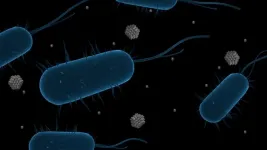INFORMATION:
Long-term memory setup requires a reliable delivery crew
Synaptic plasticity depends on molecular hauler KIF5C, carrier of more than 650 RNAs, study finds
2021-07-13
(Press-News.org) JUPITER, FL - The brain is wired for learning. With each experience, our neurons branch out to make new connections, laying down the circuitry of our long-term memories. Scientists call this trait plasticity, referring to an ability to adapt and change with experience.
For plasticity to happen, our neurons' synapses, or connection points, must constantly remodel and adapt, too. The mechanics underlying neurons' synaptic plasticity have become clearer, thanks to new research from the lab of Scripps Research neuroscientist Sathya Puthanveettil, PhD.
Scientists have learned that synaptic plasticity requires a complex relay from the neuron's cell body to its dendrite arms and its synapse junctions. Like a 24-hour port and highway network, an internal transportation system of microtubule roads and robot-like couriers shuttle the cell's vital cargo to its farthest reaches. The transported cargo allows ribosome organelles to assemble, read various RNA instructions, and build new proteins as needed in the dendrites.
In a study published July 13 in Cell Reports, Puthanveettil's team reports that among the transport network's courier molecules are two members of the Kinesin family, KIF5C and KIF3A. If KIF5C is knocked out, the team found, the neurons' ability to branch out dendrites and form input-receiving spines suffers. A gain of function to Kif5C improves these traits.
The study's first author, Supriya Swarnkar, PhD, a research associate in the Puthanveettil lab, says discerning the details of these processes points to possible causes of neurological disorders, and offers new directions for treatment. Kifs play an important role, she says.
"The ability to form memories depends on the proper functioning of the neuron's long-distance transport system from cell body to synapse," Swarnkar says. "And many studies have reported links between mutations in Kifs and neurological disorders, including intellectual disability, autism and ALS."
Structurally, many of the Kinesin family proteins resemble a walking robot, something from science fiction. They have a platform for carrying cargo, and two leg-like appendages that move back and forth, in a forward walking motion, along microtubules. In fact, they are referred to as molecular machines. These remarkable walking robots move along with their cargo on their back, until they reach their synapse destination and deposit their packages.
There are 46 different kinds of these molecular machines, specialized to carry different types of cargo, Puthanveettil says. Scientists are beginning to learn which Kifs carry which cargo.
Puthanveettil's team anticipated that KIF5C's cargo might include various RNAs. Cousin of DNA, which encode genes and reside in the nucleus, RNAs are transcribed from DNA, take its genetic instructions out to the cell's cytoplasm, build proteins encoded by the genes, and help regulate cell activities. Each different RNA has a different job.
By isolating complexes of KIF5C and their cargo, and then sequencing the RNA, they documented around 650 different RNAs that rely upon the KIF5C courier.
Significantly, this included an RNA that provides the code to initiate protein building, called EIF3G. If it doesn't show up when and where needed, compounds required for synapse plasticity aren't made. The ability to remodel the synapse with experience and to learn is impaired, Puthanveettil says.
To better understand the role of the Kifs in long-term memory storage and recall, the team carried out both loss- and gain-of-function studies both in cells and in mice, focusing on the dorsal hippocampal CA1 neurons that are involved in multiple forms of learning.
The mouse studies showed that loss of KIF5C diminishes spatial and fear-associated memory. If KIF5C is boosted in the dorsal hippocampus, on the other hand, memory is enhanced and amplified. The cells showed enhancement of synaptic transmission, arborization of dendrite arms, the neurons' arm-like extensions, and eruption of signal-receiving mushroom spines. Mushroom spine density is correlated with memory and synaptic plasticity.
Taken together, the research offers new ideas for addressing a wide variety of neuropsychiatric disorders. Intellectual disability, depression, epilepsy, Alzheimer's disease - anything that could benefit from greater or lesser expression of key proteins in neurons' dendrites might respond to a boosting or diminishing these molecular couriers, Puthanveettil says.
ELSE PRESS RELEASES FROM THIS DATE:
Farm marketing success linked to natural, cultural assets
2021-07-13
ITHACA, N.Y. - Direct farm marketing efforts, such as farmers markets and roadside stands, are more successful in communities with more nonprofits, social enterprises and creative industries, according to a team including Cornell University researchers, who created a nationwide database of assets to help municipalities craft community-specific development plans.
While many municipalities seek to encourage direct-to-consumer (DTC) marketing - an important factor in farmers' livelihoods - the success of their efforts hinges on a wide array of community resources, or capital assets, with natural and cultural ...
The two-thousand-year-old mystery of the havoc-wreaking worm
2021-07-13
AMHERST, Mass. - Humans have known for over two thousand years that shipworms, a worm-like mollusk, are responsible for damage to wooden boats, docks, dikes and piers. Yet new research from the University of Massachusetts Amherst published in Frontiers in Microbiology reveals that we still don't know the most basic thing about them: how they eat.
"It's unbelievable," says Reuben Shipway, adjunct assistant professor in microbiology at UMass Amherst, research fellow at the Centre for Enzyme Innovation at the University of Portsmouth, UK, and one of the paper's authors. "The ancient Greeks wrote about them, Christopher Columbus lost his fleet due to what he called 'the havoc which the worm had wrought,' and, today, shipworms cause billions of dollars of damage a year."
Shipworms ...
Eating whole grains linked to smaller increases in waist size, blood pressure, blood sugar
2021-07-13
Middle- to older-aged adults who ate at least three servings of whole grains daily had smaller increases in waist size, blood pressure, and blood sugar levels over time compared to those who ate less than one-half serving per day, according to new research.
Published July 13, 2021, in the Journal of Nutrition, the study by researchers at the Jean Mayer USDA Human Nutrition Research Center on Aging at Tufts University examined how whole- and refined-grain intake over time impacted five risk factors of heart disease: Waist size, blood pressure, blood sugar, triglyceride, and HDL ("good") cholesterol.
Using data from the Framingham Heart Study Offspring ...
How well do consumers understand their dairy purchases?
2021-07-13
Philadelphia, July 13, 2021 - Consumers may have less trust in food processes that they don't understand, and animal-based foods may be subject to more uninformed scrutiny than other foods due to consumers' perception of higher risk. Dairy producers can benefit from understanding how consumers interpret unfamiliar terms and claims on dairy product labels. In a new END ...
COVID-causing coronavirus following predictable mutational footsteps
2021-07-13
New research from the University of Nebraska-Lincoln has shown that the mutations arising in the COVID-19-causing SARS-CoV-2 virus seem to run in the family -- or at least the genus of coronaviruses most dangerous to humans.
After comparing the early evolution of SARS-CoV-2 against that of its closest relatives, the betacoronaviruses, the Nebraska team found that SARS-CoV-2 mutations are occurring in essentially the same locations, both genetically and structurally.
The mutational similarities between SARS-CoV-2 and its predecessors, including the human-infecting SARS-CoV-1 and MERS-CoV, could help inform predictions of how the COVID-causing virus will continue to evolve, the researchers ...
Taming the Huntington's disease proteome: Mass spectrometry may provide answers
2021-07-13
Amsterdam, July 13, 2021 - Mass spectrometry has emerged as an important analytical tool for gaining a better understanding of mechanisms underlying Huntington's disease (HD), alongside the increased availability of cell and animal models of the disease. This END ...
What you say in the first minute after a vaccine can be key in reducing a child's distress
2021-07-13
YorkU pain research finds what you say in the first minute after a vaccine can be key in reducing a child's future distress
New study finds it's not just what say, but when you say it that can keep preschoolers calmer during vaccinations
TORONTO, July 13, 2021 - As we look forward to a fall with hopefully one of the most important vaccination uptakes of children in a generation, a new study provides insights to help parents with reducing post-vaccination distress in younger kids. The study, published in END ...
US-wide, non-white neighborhoods are hotter than white ones
2021-07-13
WASHINGTON--In cities and towns across the United States, neighborhoods with more Black, Hispanic and Asian residents experience hotter temperatures during summer heatwaves than nearby white residents, a new study finds. It is the first to show that the trend, documented in some major cities, is widespread, even in small towns, nationwide.
According to the new nationwide study, these racial disparities exist because non-white neighborhoods tend to be more densely built up with buildings and pavement that trap heat and have fewer trees to cool the landscape.
"Urban climate is different from temperatures outside the city," said co-author Susanne Benz, an ...
Are silver nanoparticles a silver bullet against microbes?
2021-07-13
Antimicrobials are used to kill or slow the growth of bacteria, viruses and other microorganisms. They can be in the form of antibiotics, used to treat bodily infections, or as an additive or coating on commercial products used to keep germs at bay. These life-saving tools are essential to preventing and treating infections in humans, animals and plants, but they also pose a global threat to public health when microorganisms develop resistance to them, a concept known as antimicrobial resistance.
One of the main drivers of antimicrobial resistance is the misuse and overuse of antimicrobial agents, which includes silver nanoparticles, ...
Study: Racial/ethnic and language inequities in ways patients obtain COVID-19 testing
2021-07-13
The COVID-19 pandemic caused an unprecedented disruption to health care delivery, with resources shifted toward telehealth services and mass viral testing. While early studies in the pandemic highlighted differences in health care utilization among patients with commercial insurance, data from publicly insured or uninsured "safety-net" patient populations continue to emerge.
A recent study from researchers at the University of Minnesota and Hennepin Healthcare Research Institute (HHRI) is among the first to examine how different socio-demographic groups used telehealth, outpatient (i.e., clinic), emergency department and inpatient (i.e., hospital) care to test for SARS-CoV-2, the virus that causes COVID-19. ...
LAST 30 PRESS RELEASES:
Making lighter work of calculating fluid and heat flow
Normalizing blood sugar can halve heart attack risk
Lowering blood sugar cuts heart attack risk in people with prediabetes
Study links genetic variants to risk of blinding eye disease in premature infants
Non-opioid ‘pain sponge’ therapy halts cartilage degeneration and relieves chronic pain
AI can pick up cultural values by mimicking how kids learn
China’s ecological redlines offer fast track to 30 x 30 global conservation goal
Invisible indoor threats: emerging household contaminants and their growing risks to human health
Adding antibody treatment to chemo boosts outcomes for children with rare cancer
Germline pathogenic variants among women without a history of breast cancer
Tanning beds triple melanoma risk, potentially causing broad DNA damage
Unique bond identified as key to viral infection speed
Indoor tanning makes youthful skin much older on a genetic level
Mouse model sheds new light on the causes and potential solutions to human GI problems linked to muscular dystrophy
The Journal of Nuclear Medicine ahead-of-print tip sheet: December 12, 2025
Smarter tools for peering into the microscopic world
Applications open for funding to conduct research in the Kinsey Institute archives
Global measure underestimates the severity of food insecurity
Child survivors of critical illness are missing out on timely follow up care
Risk-based vs annual breast cancer screening / the WISDOM randomized clinical trial
University of Toronto launches Electric Vehicle Innovation Ontario to accelerate advanced EV technologies and build Canada’s innovation advantage
Early relapse predicts poor outcomes in aggressive blood cancer
American College of Lifestyle Medicine applauds two CMS models aligned with lifestyle medicine practice and reimbursement
Clinical trial finds cannabis use not a barrier to quitting nicotine vaping
Supplemental nutrition assistance program policies and food insecurity
Switching immune cells to “night mode” could limit damage after a heart attack, study suggests
URI-based Global RIghts Project report spotlights continued troubling trends in worldwide inhumane treatment
Neutrophils are less aggressive at night, explaining why nighttime heart attacks cause less damage than daytime events
Menopausal hormone therapy may not pose breast cancer risk for women with BRCA mutations
Mobile health tool may improve quality of life for adolescent and young adult breast cancer survivors
[Press-News.org] Long-term memory setup requires a reliable delivery crewSynaptic plasticity depends on molecular hauler KIF5C, carrier of more than 650 RNAs, study finds




